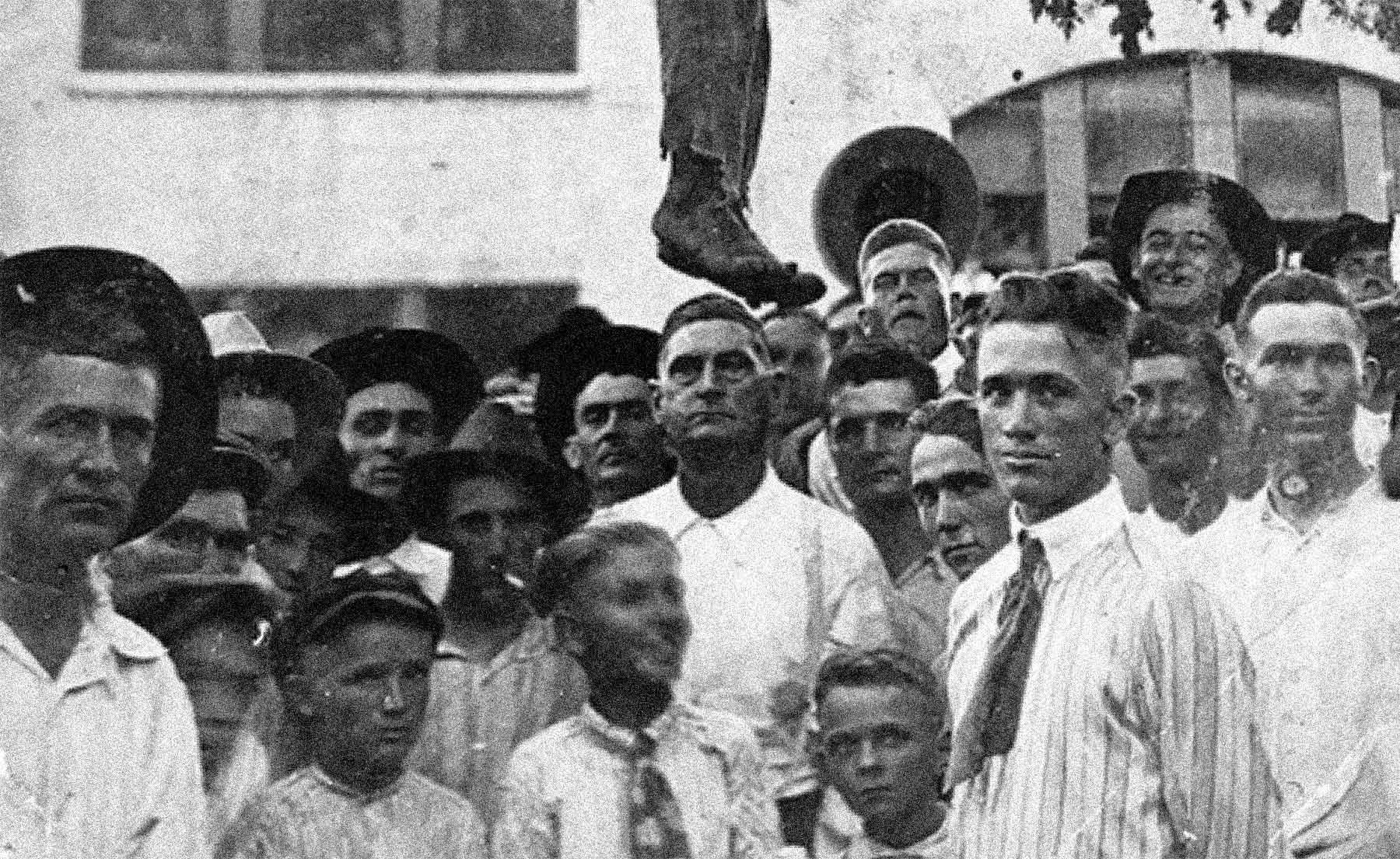
Men and boys pose beneath the body of Lige Daniels, a Black man, shortly after he was lynched on August 3, 1920, in Center, Texas. (James Allen,ed., et al., Without Sanctuary: Lynching Photography in America (Santa Fe, NM: Twin Palms Publishers, 2000), 117-118.)
Today, the story of the American Civil Rights Movement is familiar: courageous activists waged an epic struggle, faced great risks, and suffered tragic losses to achieve victories that forever changed the nation. Rosa Parks and the Montgomery Bus Boycott; the murder of Emmett Till; the Selma to Montgomery March; and the assassination of Martin Luther King Jr. in 1968 are well-known milestones in the movement.
In contrast, the story of national opposition to civil rights is muddled and incomplete. If civil rights activists’ efforts constituted a soaring chorus of We Shall Overcome, hundreds of thousands of white opponents responded with a deafening shout: “No you will not!”
White Americans concentrated in the South and influential throughout the country conducted a widespread, organized, and determined campaign to defend their “way of life” against the “burden of integration.”1 Jason Sokol, “White Southerners’ Reactions to the Civil Rights Movement,” in Free At Last, Bureau of International Information Programs (U.S. Dept. of State, 2008), http://iipdigital.usembassy.gov/st/ english/publication/2009/01/20090106143801jmnamdeirf0.9369623. html#axzz3FyyeCkJL. Racist politicians enjoyed support from the majority of white voters; the Ku Klux Klan claimed many of the South’s most prominent and powerful citizens as members;2 David Cunningham, Klansville USA: The Rise and Fall of the Civil Rights-Era Ku Klux Klan (New York: Oxford University Press, 2013), 25. and white perpetrators of vicious attacks on Black people were regularly acquitted by all-white juries.3 Hiroshi Fukurai and Richard Krooth, Race in the Jury Box: Affirmative Action in Jury Selection (Albany: SUNY Press, 2003), 10.
Understanding this opposition to civil rights can help us address its legacy today.
On February 7, 1904, a Black man and woman were tortured and killed in Sunflower County, Mississippi, as hundreds of white people watched and cheered. The man, Luther Holbert, was accused of fatally shooting James Eastland, a white landowner from a prominent and wealthy family. Eastland’s brothers, Woods and Hiram, led the posse that captured Holbert as he fled with a Black woman whose name was not reported.4 J. Todd Moye, Let the People Decide: Black Freedom and White Resistance Movements in Sunflower County, Mississippi, 1945-1986 (Chapel Hill: UNC Press, 2004), 14. Many contemporary reports published in white newspapers indicate that the woman was Mr. Holbert’s wife, but none lists her name. Census records suggest that Luther Holbert’s wife and children were living in Forest, Mississippi, at the time, and the woman lynched with Mr. Holbert may have been Emma Carr, the wife of another man killed in the shootout with James Eastland.
Eyewitnesses reported that members of the mob prepared funeral pyres while Luther Holbert and the Black woman, each tied to a tree, watched. They were forced to hold out their hands as their fingers were chopped off, one at a time, and distributed as souvenirs. Then their ears were cut off and handed out as prizes. Holbert was beaten until his skull fractured and one eye hung from its socket. Mob members then used a large corkscrew to bore into their arms, legs, and torsos, pulling out large pieces of flesh before throwing both victims on the fire to burn to death. The event was described as festive, with 600 spectators enjoying deviled eggs, lemonade, and whiskey.5 Ibid., 3-15; Greenville (Miss.) Weekly Democrat Times, “Gruesome Relics Handled Gingerly,” February 27, 1904.
For a generation of white Americans who bitterly fought civil rights progress, Eastland and leaders like him linked the era of racial terror in which they were born to the era of inequality and Jim Crow segregation.
Later that year, Woods Eastland named his newborn son for his slain brother. 6 Chris Myers Asch, The Senator and the Sharecropper: The Freedom Struggles of James O. Eastland and Fannie Lou Hamer (Chapel Hill: UNC Press, 2011), 33-34. James Oliver Eastland, the privileged son of a wealthy plantation-owning white family on the Mississippi Delta, became a lawyer and the state’s longest serving United States senator. Eastland committed his 36-year Senate career to maintaining white supremacy. From 1942 to 1978, he defended Mississippi’s deeply rooted racial caste system and led the virulent white opposition to school desegregation, Black voting rights, and racial equality.
Long before the mid-20th century, the South earned a reputation as a white supremacist stronghold with a deeply entrenched racial hierarchy; legal, political, and economic systems designed to perpetuate racial inequality; and a willingness to maintain that system through any means necessary.
On the eve of the Civil War, 90 percent of America’s Black population was enslaved, and those 3.9 million enslaved Black people were held in the South.7 Inter-University Consortium for Political and Social Research, “Historical, Demographic, Economic, and Social Data: The United States, 1790-1970” [Computer file] (Ann Arbor, MI: Inter-University Consortium for Political and Social Research, 1997).
When shifting national sentiment threatened federal interference with slavery, South Carolina seceded from the Union to form the Confederacy in December 1860, and the Civil War began in April 1861.8 Buffalo (N.Y.) Daily Republic, “The Surrender of Ft. Sumter Demanded and Declined: A Bloody War Anticipated Every Moment,” April 12, 1861. Four years later, the rebels were defeated, Black people were emancipated, and white Southerners began rebuilding a society that recreated white supremacy.
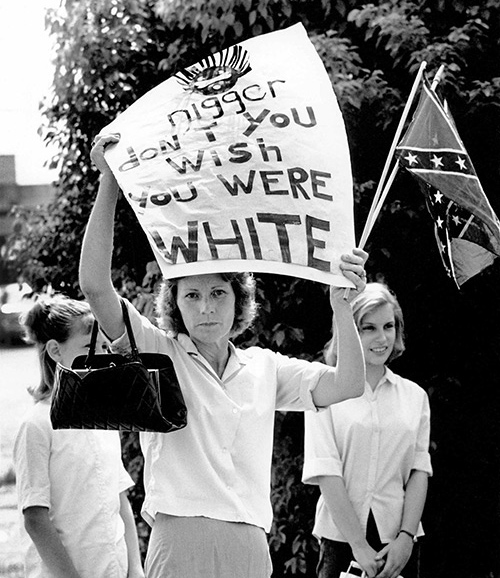 Bogalusa, Louisiana, July 1, 1965.
(© 1976, Matt Herron/The Image Works)
During Reconstruction, violence, lynchings, and large scale massacres were used to maintain white control. “How many Black men and women were beaten, flogged, mutilated, and murdered in the first years of emancipation will never be known,” wrote historian
Leon F. Litwack.9
Leon F. Litwack, Been in the Storm So Long: The Aftermath of Slavery
(New York: Random House, 1980), 276-77.
After federal troops withdrew, racial terror lynchings by white mobs terrorized millions of Black people, and more than 4000 were killed between 1877 and 1950, mostly in the South. Enabled by the indifference of federal officials and Northern
states, this violence traumatized the Black community for generations.10
Equal Justice Initiative, Lynching in America: Confronting the Legacy
of Racial Terror (3d Ed., 2017).
Bogalusa, Louisiana, July 1, 1965.
(© 1976, Matt Herron/The Image Works)
During Reconstruction, violence, lynchings, and large scale massacres were used to maintain white control. “How many Black men and women were beaten, flogged, mutilated, and murdered in the first years of emancipation will never be known,” wrote historian
Leon F. Litwack.9
Leon F. Litwack, Been in the Storm So Long: The Aftermath of Slavery
(New York: Random House, 1980), 276-77.
After federal troops withdrew, racial terror lynchings by white mobs terrorized millions of Black people, and more than 4000 were killed between 1877 and 1950, mostly in the South. Enabled by the indifference of federal officials and Northern
states, this violence traumatized the Black community for generations.10
Equal Justice Initiative, Lynching in America: Confronting the Legacy
of Racial Terror (3d Ed., 2017).
Transitioning from enslavement to legalized white supremacy required a new legal architecture. In the 1890s, Mississippi, South Carolina, and Louisiana adopted new state constitutions that denied Black people the vote, reflecting segregationists’
conviction that “[w]e can trust white men to do right by their inferior race, but we cannot trust the inferior race with power over the white man.”11
Orangeburg (S.C.) Times and Democrat, “The Black Flag Once More,”
February 13, 1895.
In 1901, Alabama followed suit and held a constitutional convention “to establish white supremacy in this state.”12
Alabama State Legislature, Official Proceedings of the Constitutional
Convention of the State of Alabama (Montgomery, AL: May 22, 1901
to Sept. 3, 1901).
With white control of state and local government restored, lawmakers passed legislation that required racial separation in major and mundane areas of life.
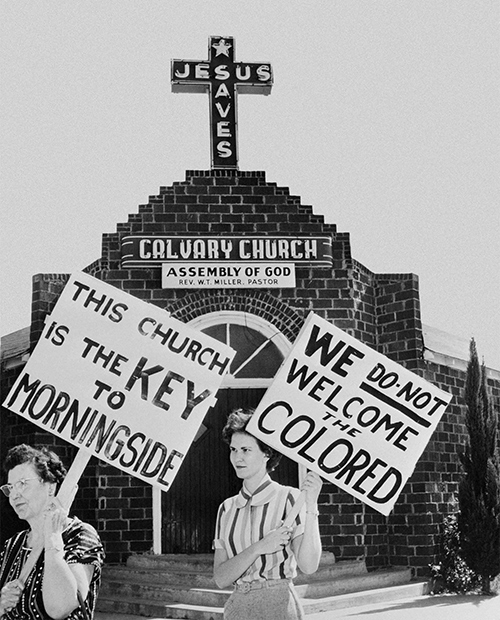 White women protest
desegregation in front of a church in Fort
Worth, Texas, on October 9, 1956. (AP)
In 1905, the City of Ensley, Alabama, required all barbers to use separate razors, brushes, linens, and chairs for Black and white patrons,13
Code of the City of Ensley, Alabama, § 652 (September. 7, 1905).
while the City of Birmingham outlawed interracial games of pool, cards, dice, dominoes, checkers, and billiards.
14
Code of the City of Birmingham, Alabama, § 18 (March 1, 1915).
Arkansas and Florida segregated Black and white prisoners, and in 1939, Louisiana required circuses to maintain separate, racially segregated tent entrances and ticket booths.
15
La. Gen. Stat. § 9791 (1939).
Hospitals, public transportation, and public schools were segregated throughout the South.
White women protest
desegregation in front of a church in Fort
Worth, Texas, on October 9, 1956. (AP)
In 1905, the City of Ensley, Alabama, required all barbers to use separate razors, brushes, linens, and chairs for Black and white patrons,13
Code of the City of Ensley, Alabama, § 652 (September. 7, 1905).
while the City of Birmingham outlawed interracial games of pool, cards, dice, dominoes, checkers, and billiards.
14
Code of the City of Birmingham, Alabama, § 18 (March 1, 1915).
Arkansas and Florida segregated Black and white prisoners, and in 1939, Louisiana required circuses to maintain separate, racially segregated tent entrances and ticket booths.
15
La. Gen. Stat. § 9791 (1939).
Hospitals, public transportation, and public schools were segregated throughout the South.
The narrative of racial difference created to justify slavery — the myth that white people are superior to Black people — was not abolished by the Emancipation Proclamation or the Thirteenth Amendment, and it outlived slavery and Reconstruction. White
Americans committed to the myth of Black inferiority used the law and violent terrorism to establish an apartheid society that relegated Black Americans to second-class citizenship and economic exploitation.
In 1940, 77 percent of Black Americans still lived in the South,16
United States Census Bureau, Population Division Working Paper
No. 56, Historical Census Statistics On Population Totals by Race, 1790 to
1990, and by Hispanic Origin, 1970 to 1990, for the United States, Regions,
Divisions, and States (Washington, DC: 2002), Tb. 1, 19; Tb. 4, 22.
where they made up 24 percent of the population but only 3.5 percent of registered voters.17
Doug McAdam, Political Process and the Development of Black
Insurgency, 1930-1970 (Chicago: University of Chicago Press, 1999),
79; Anne Permaloff and Carl Grafton, Political Power in Alabama: The
More Things Change...(Athens: University of Georgia Press, 2008), 42.
The white-controlled Democratic Party made white supremacy a central platform,18
Hazelton (Penn.) Plain Speaker, “White Supremacy Mississippi Issue,
Lawrence,” June 5, 1944.
The crux of the interparty battle appears to lie in Mississippi, where
Democrats meet Wednesday to pick a delegation to cast 20 votes on
the presidential and vice presidential nominations. ‘White supremacy’
was advanced as a theme of a meeting expected to develop an effort
to keep the delegation uninstructed.
excluded Black members as a matter of policy,19
Constitutional Rights Foundation, “Race and Voting in the
Segregated South,” June 2000.
and dominated state politics throughout the region.
Suppressing Black voters ensured the 1942 election of James O. Eastland as United States senator from Mississippi. Eastland would build a six-term career leading a national movement opposed to civil rights.
Black people were systematically excluded, disenfranchised, disempowered, and marginalized in most communities. In the American South, racial humiliation was a daily experience. A political, social, economic, and cultural landscape that could only be enforced through violence and intimidation had been created to oppress and disfavor Black people.
In the 1940s, the frequency of lynchings declined but racial terrorism did not stop. Jesse Thornton was lynched in Luverne, Alabama, in 1940 for addressing a white policeman without the title “Mr.”; 15-year-old Willie Howard was lynched in 1944 in Suwannee County, Florida, for sending a love note to a white girl; and Reverend Isaac Simmons, a Black landowner, was lynched in 1944 in Amite County, Mississippi, by white men seeking to steal his land.20 Baltimore (Md.) Afro-American, “Lynched Because He Didn’t Say ‘Mr.,’” August 24, 1940; Jeffrey L. Kirchmeier, Imprisoned by the Past: Warren McCleskey and the American Death Penalty (New York: Oxford University Press, 2015), 123; New York Amsterdam News, “Miss. Minister Lynched, August 26, 1944. Rev. Isaac Simmons, a Black man who owned 270 acres of debt-free land in Amite County Mississippi, and had for several years resisted a group of white men seeking to take it from him, was killed by those men in March 1944. The men abducted Rev. Simmons and his son, Eldridge, shot the reverend three times and cut out his tongue, then warned Eldridge to leave the land with the rest of his family within ten days lest they be killed too. Terrified, the Simmons family fled and the killers took possession of the land; only one of the white men faced charges for the murder, and he was acquitted by an all-white jury.
Members of lynch mobs were rarely prosecuted, and even in those rare cases, all-white juries refused to convict. In Pickens County, South Carolina, 26 of the 28 white men charged in the 1947 lynching of Willie Earle admitted their involvement, but white jurors acquitted them.21 James E. Boyack, “Pearson Foresees Retrial in Lynch Case; Flays Jury,” Pittsburgh (Pa.) Courier, May 31, 1947.
Civil rights activists were targets of racial terror in this era. In 1940, as part of the National Association for the Advancement of Colored People (NAACP), Elbert Williams organized a voter registration drive in Brownsville, Tennessee, a group of white men that included the sheriff abducted him from his home. His beaten corpse was found in the Hatchie River days later. No one was prosecuted. The remaining Black activists were run out of town and Brownsville’s NAACP chapter remained suppressed until 1961.22 Atlanta (Ga.) Daily World, “Vote Test Is Made In Tennessee,” September 11, 1940; Marvel Cooke, “Mob Victim’s Widow Interviewed Here,” New York Amsterdam News, July 13, 1940; Atlanta (Ga.) Daily World, “Body of Tenn. Leader Found,” June 26, 1940; Pittsburgh (Pa.) Courier, “New NAACP Unit Formed In Brownsville, Tenn.,” May 13, 1961.
Racial violence was not restricted to the South. Millions of Black Americans fled to the North and West, where they were seen as threats to white jobs and culture.
In 1942, white people in Detroit attacked Black families and rioted against a planned public housing project for Black residents.23 Harvard Sitkoff, The Detroit Race Riot of 1943, Toward Freedom Land: The Long Struggle for Racial Equality in America (Lexington: University Press of Kentucky, 2010), 43-64. The next year, some 25,000 white factory workers at Detroit’s Packard Motor Company refused to work after three Black workers were promoted.24 John Barnard, American Vanguard: the United Auto Workers During the Reuther Years (Detroit: Wayne State University Press, 2005), 191- 96; Nat Brandt, Harlem at War: The Black Experience During WWII (Syracuse: Syracuse University Press, 1996), 144-51; James T. Sparrow, Warfare State (New York: Oxford University Press, 2013), 184-87.
And in August 1944, white transit workers in Philadelphia staged a violent strike after eight Black men were hired as trolley drivers — a job previously reserved for whites only.25 Milwaukee (Wis.) Sentinel, “Army Takes Over Transit Lines; Workers Claim Victory on Race Issue,” August 4, 1944; New York Times, “Return to Work Is Opposed,” August 4, 1944; Chicago Daily Tribune, “Army Seizes Philadelphia Transit Lines; Strikers Balk: Vote To Work Revoked Over Negro Status,” August 4, 1944.
In Fontana, California, a Black man named O’Day Short, his wife Helen, and their two young children were killed in a December 1945 explosion at their new home after they refused to move out of the formerly all-white neighborhood. Though an NAACP investigation uncovered evidence of arson, police declared the fire an accident and closed the case.26 Chicago Defender, “3 Die in Blaze after Threat,” December 29, 1945; Atlanta (Ga.) Daily World, “Mother, Children Fatally Seared; Covenant Blamed,” December 23, 1945; Fontana (Calif.) Herald, “Origin of Tragic Blaze Unknown,” January 3, 1946; Myra Tanner Weiss, Vigilante Terror in Fontana: The Tragic Story of O’Day H. Short and his Family (Los Angeles: Socialist Workers Party of Los Angeles, 1946).
Unchecked racialized violence and disenfranchisement of Black voters kept America’s racial hierarchy intact. Public education was legally segregated throughout the South, and residential segregation in the North and West was widespread. Leisure and recreation spaces across the country were segregated by race, and many states banned interracial marriage.27 Article 14, Section 263 of the Mississippi Constitution of 1890: “The marriage of a white person with a Negro or mulatto, or person who shall have one-eighth or more of Negro blood, shall be unlawful and void.” This provision remained in force until invalidated by the United States Supreme Court’s 1967 decision in Loving v. Virginia, 388 U.S. 1 (1967).
In 1948, 24 people were arrested in Baltimore for attempting to play tennis in interracial groups.28 Baltimore (Md.) Sun, “Police Stop Interracial Tennis and Arrest 24,” July 12, 1948. In Ellisville, Mississippi, Davis Knight was sentenced to five years in prison for marrying a white woman.29 Washington Post, “Mississippian Is Convicted of Miscegenation,” December 19, 1948. Segregation and inequality remained deeply rooted in America, but international criticism forced some changes after World War II.
During World War II, American leaders resented the way that German and Japanese propagandists “made the most of the anti-Negro discrimination in this country.”30 Gene Weltfish, “American Racism: Japan’s Secret Weapon,” Far Eastern Survey 14, no. 17 (1945): 236. And after the war, “[t]he Cold War focus on the ideals of democracy and freedom assured that racial exceptions to the American practice of those principals would receive careful attention,” one historian observed. “Acts of racial violence in obscure rural parts of Dixie changed almost overnight from events of mostly local interest to headlines splashed across newspapers around the world.”31 Thomas Borstelmann, The Cold War and the Color Line: American Race Relations in the Global Arena (Cambridge: Harvard University Press, 2003), 74-75. Federal officials and Northern elites who had been indifferent to generations of racial violence and discrimination became more responsive when the issue threatened national political interests and not just Black lives.
In 1942, in response to Black leaders’ threat to stage a march on Washington, President Franklin D. Roosevelt signed Executive Order 8802, which prohibited racial discrimination in the national defense industry.32 Christopher S. Parker, Fighting for Democracy: Black Veterans and the Struggle Against White Supremacy in the Postwar South (Princeton: Princeton University Press, 2009), 43-44. Six years later, President Harry Truman signed Executive Order 9981, which abolished racial discrimination in the military and ended segregation in the armed forces.33 Raymond H. Geselbracht, The Civil Rights Legacy of Harry S. Truman (Kirksville, Missouri: Truman State University Press, 2007), 110.
In 1944, a NAACP lawsuit challenging the Democratic Party’s all-white primaries led to a decision striking down the practice in Texas34 Smith v. Allwright, 321 U.S. 649 (1944). that ultimately ended segregated primaries in all Southern states.35 Stephen Tuck, “Black Protest During the 1940s: The NAACP in Georgia,” in The Civil Rights Movement Revisited: Critical Perspectives on the Struggle for Racial Equality in the United States, ed. Patrick B. Miller, Therese Frey Steffen and Elisabeth Schäfer-Wünsche (Piscataway, New Jersey: Transaction Publishers, 2001), 63. In 1946, the Supreme Court declared state segregation laws unconstitutional as applied to interstate bus travel.
At the same time, grassroots activism against segregation was on the rise.
Many Black soldiers returned to the South determined to achieve a “double victory” by fighting oppression on American soil just as they had fought oppression abroad.36 Pittsburgh (Pa.) Courier, “The Courier’s Double-V for a Double Victory Campaign Gets Country-Wide Support,” February 14, 1942.
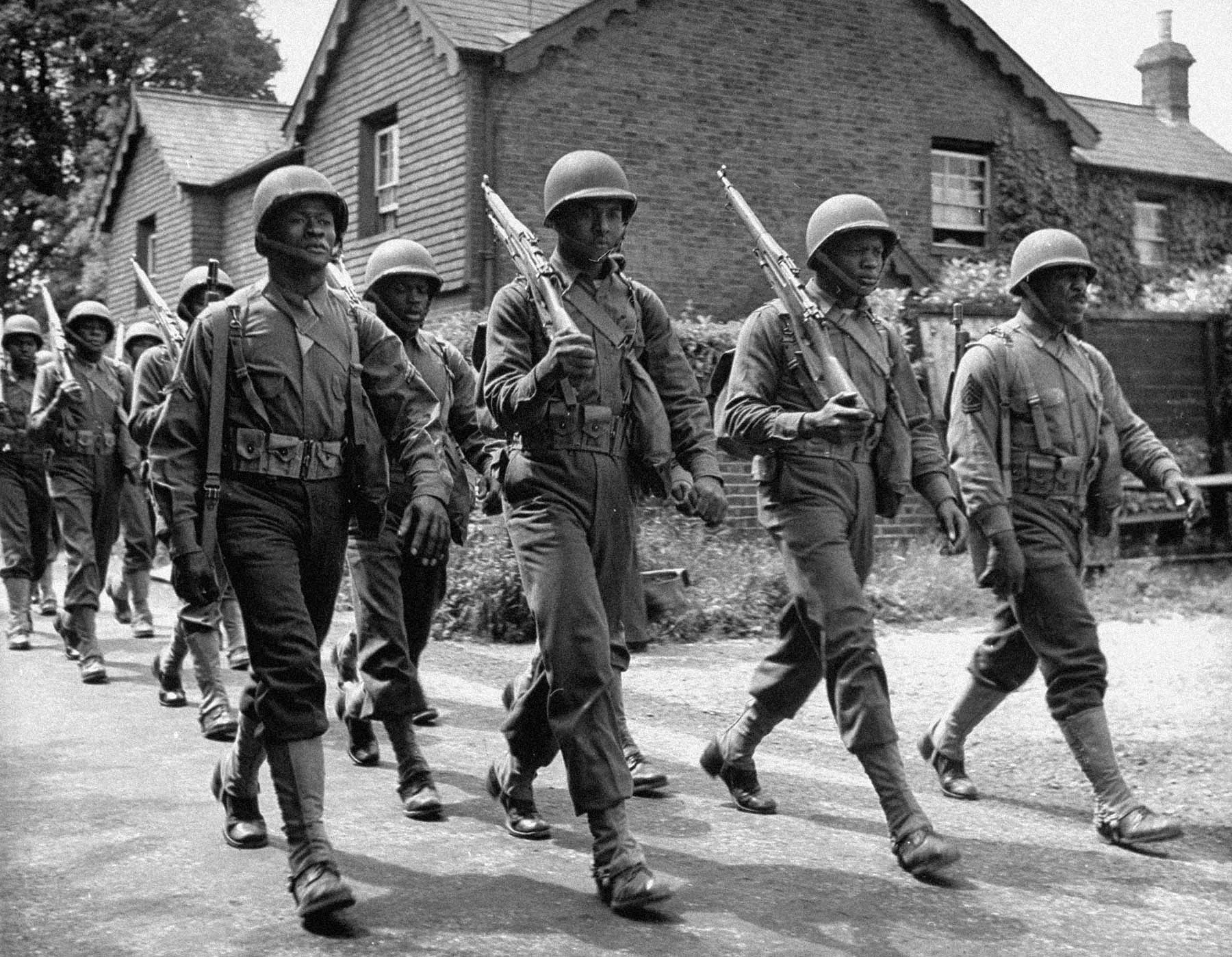
First African American troops ever sent to England, marching back to camp during World War II, 1942. (David E. Scherman/The Life Picture Collection/Getty Images)
Between 1940 and 1946, NAACP membership grew from less than 50,000 to nearly a half million, and a third of these were based in the South. 37 Tuck, “Black Protest During the 1940s,” 63. A Black veteran named Medgar Evers helped the organization sprout branches throughout Mississippi in the 1940s and to charter a statewide conference in 1945. 38 Mississippi NAACP, “Mississippi NAACP History,”accessed February 27, 2018, http://naacpms.org/history/. In 1942, 2000 people attended a mass meeting in Harlem, New York, at which speakers called on President Roosevelt to condemn lynching. 39 Patricia Michelle Boyett, Right to Revolt: The Crusade for Racial Justice in Mississippi’s Central Piney Woods (Jackson: University Press of Mississippi, 2015), 41.
Segregationists recognized these developments as a growing threat. In what historian Jason Morgan Ward calls “a white supremacist vision of Double Victory,” white Americans “deemed civil rights agitation and federal encroachment to be as dangerous as an Axis invasion” and considered themselves defenders of true American values.40 Jason Morgan Ward, “A War for States’ Rights: The White Supremacist Vision of Double Victory,” in Fog of War: The Second World War and the Civil Rights Movement, eds. Kevin Kruse and Stephen Tuck (New York: Oxford University Press, 2012), 127.
Southern senators successfully undercut President Roosevelt’s executive order by refusing to support nondiscrimination rules in military contracts and eliminating funding to enforce them.41 Ronald Takaki, Double Victory: A Multicultural History of America in World War II (Boston: Little, Brown, 2000), 97; Frederickson, Dixiecrat Revolt, 13, 32; Parker, Fighting for Democracy, 34.
South Carolina politicians attempted to sidestep the Supreme Court’s ban on all-white primaries by requiring all primary voters to swear to support “the social, religious, and educational separation of races.”42 Brown v. Baskin, 78 F. Supp. 933 (E.D. S.C. 1948). When that rule was struck down, white residents resorted to violent intimidation. After Reverend Archie Ware, a Black man, voted in the 1948 primary in Abbeville County, South Carolina, a group of white men beat and stabbed him while two white police officers watched.43 Barry Saunders, “Saunders: Not voting? That should never be an option,” Raleigh (N.C.) News and Observer, November 5, 2012; Salt Lake (Utah) Tribune, “Negro Cleric Beaten, Cut at S.C. Polls,” August 24, 1948.
In Florida, Hillsborough County Supervisor of Registration John Deckle openly defied the Court and declared, “Negroes will not be allowed to vote as Democrats.”44 Pam Iorio, “Colorless Primaries: Tampa’s White Municipal Party,” Florida History Quarterly 79, no. 297 (2001): 311.
In 1947, the Mississippi Democratic Party issued five rules “to bring about complete white supremacy at the polls” by requiring that potential party primary voters (1) oppose the creation of a committee on fair employment practices; (2) oppose anti-poll tax legislation; (3) oppose passage of a federal anti-lynch law; (4) support all party candidates in general elections; and (5) repudiate affiliation with any other party.45 St. Petersburg (Fla.) Evening Independent, “Mississippi Demos List Five Rules for ‘White Supremacy,’” May 15, 1947.
In 1948, Mississippi Governor Fielding L. Wright threatened to secede from the national Democratic Party if it pursued “anti-Southern” policies “seeking to tear down and disrupt the Southern way of life — which includes segregation of Negroes.”
Segregationists were not marginalized figures clinging to a dying system; rather, their views were embraced by mainstream America.
Public opinion polls in the 1940s reported that approximately two of every three white Americans supported racially segregated schools,46 M. Krysan and S. Moberg, “Trends in Racial Attitudes,” University of Illinois Institute of Government and Public Affairs, August 25, 2016, http://igpa.uillinois.edu/programs/racial-attitudes. One of the most substantial changes in white racial attitudes has been the movement from very substantial opposition to the principle of racial equality to one of almost universal support. For example, in 1942, just 32 percent of white Americans agreed that white and Black children should attend the same schools; in 1995, when the question was last asked, 96 percent of white respondents agreed. In 1944, only 45 percent of white people agreed that Black people should have ‘as good a chance as white people to get any kind of job,’ but by 1972 almost all white respondents agreed with this statement on equal opportunity (97 percent). and a majority supported racial discrimination in hiring.47 Ibid.
A month before President Truman desegregated troops in July 1948, polls showed that 63 percent of Americans opposed integrating the military. 48 Igor Volsky, “Exclusive: Records Show Military Surveyed Troops in 1940s, Prior to Racially Integrating the Forces,” ThinkProgress.org, July 21, 2010, https://thinkprogress.org/exclusive-records-show-militarysurveyed-troops-in-1940s-prior-to-racially-integrating-the-forcesafc346d8d4d2.
Truman’s support for federal legislation to end lynching, poll taxes, and segregation in interstate travel49 Kari A. Frederickson, The Dixiecrat Revolt and the End of the Solid South, 1932-1968 (Chapel Hill: UNC Press, 2001), 2-3. was the last straw for many Southern politicians, who formed the States’ Rights Party in 1948.50 Ibid., 3.
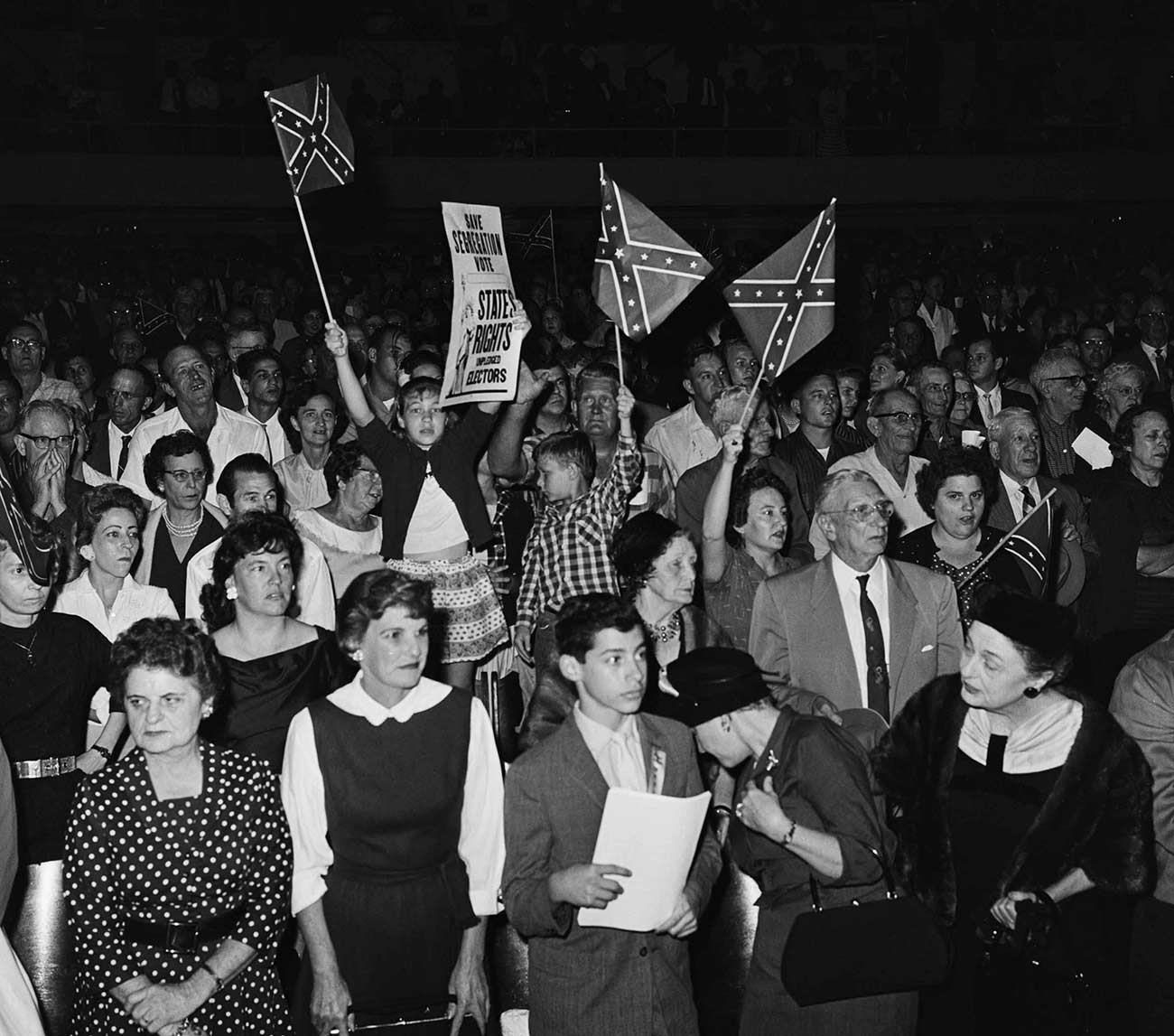
Young children wave Confederate flags at a White Citizens’ Council meeting in New Orleans, Louisiana, on November 16, 1960. The meeting was called to organize opposition to the integration of two local elementary schools. (Bettman / Getty Images)
The so-called Dixiecrats planned to leverage the Southern states’ electoral votes to defend racial segregation and maintain white supremacy.51 Ibid. They nominated first-term South Carolina Governor Strom Thurmond for president and Mississippi Governor Fielding Wright as his running mate. At the convention, Thurmond declared, “There is not enough troops in the army to force the southern people to break down segregation and admit the nigger race into our theaters, into our swimming pools, into our homes, and into our churches.”52 Joseph Crespino, Strom Thurmond’s America: A History (New York: Hill and Wang, 2011), 71.
The Dixiecrats carried Mississippi, Alabama, Louisiana, and South Carolina in 1948, and won 2.4 percent of the popular vote — more than 1.1 million votes nationwide.53 U.S. Election Atlas, “1948 Presidential General Election Data – National,” accessed February 27, 2018, https://uselectionatlas.org/RESULTS/data. php?year=1948&datatype=national&def=1&f=0&off=0&elect=0.
Truman won in a landslide, and the States’ Rights Party faded, but the defectors stayed in power. James Eastland, Mississippi’s senior senator by 1948, was a major coordinator of the Dixiecrat campaign but returned to the Senate as a Democrat and became chair of the civil rights subcommittee. 54 Maarten Zwiers, Senator James Eastland: Mississippi’s Jim Crow Democrat (Baton Rouge: Louisiana State University Press, 2015, 85; Democrat and Chronicle (Rochester, New York), “Foe of Civil Rights Heads Senate Unit,” September 16, 1949.
The Dixiecrat revolt began the South’s gradual shift from the Democratic Party to the Republican Party and cemented a white supremacist identity, a states’ rights narrative, and a model of uncompromising segregationist leadership.55 Kevin Michael Kruse and Stephen Tuck, “Introduction,” in Fog of War: The Second World War and the Civil Rights Movement (New York: Oxford University Press, 2012), 10. The power of white segregationists at the end of the war meant that a breakthrough civil rights movement seemed far from inevitable, [and] provided a reminder, if one was needed, that any future Black activism or federal interference could expect massive resistance.
After more than a decade in the Senate, former Mississippi Governor Theodore Bilbo in 1947 wrote Take Your Choice: Separation
or Mongrelization as an “S.O.S. call to every white man and white woman within the United States of America for immediate action.”56
Theodore Bilbo wrote “Preface,” in Take Your Choice: Separate or
Mongrelization (Literary Licensing, LLC, 1947), 54.
"Personally, the writer of this book would rather see his race
and his civilization blotted out with the atomic bomb than to see
it slowly but surely destroyed in the maelstrom of miscegenation,
interbreeding, intermarriage and mongrelization. The
destruction in either case would be inevitable - one in a flash and
the other by the slow but certain process of sin, degradation, and
mongrelization.
It is not too late - we can yet save the integrity and civilization
of both the white and the Black races. Many great men of
the past have suggested the only solution - the only salvation.
A physical separation as advocated from the days of Thomas
Jefferson to the present is the only solution. To do this may be a
Herculean task, but it is not impossible.
On the pages of this book the author has tried to give you
the indisputable truth, expose forces and influences that seek
the amalgamation of our races and has pointed out the only
proper solution to America’s greatest domestic problem. May God in His infinite wisdom and mercy direct us and lead us into the
ways of our only salvation."
A fierce proponent of white supremacy throughout his political career, Bilbo ended his time in office with a message to the next generation. He urged white Americans to ensure complete and permanent racial separation by repatriating Black Americans
to West Africa, warning that “[t]he campaign for complete equality launched by the Negro leaders has now reached alarming proportions.”57
Ibid., chapters I and XIII.
For more than a century before its groundbreaking decision to desegregate public schools in 1954, the Supreme Court protected slavery, undermined equal rights, immunized lynch mobs from punishment, and embraced Jim Crow. Brown v. Board of Education was a striking departure from the Court’s longstanding role shielding the South from challenges to its racial caste system.
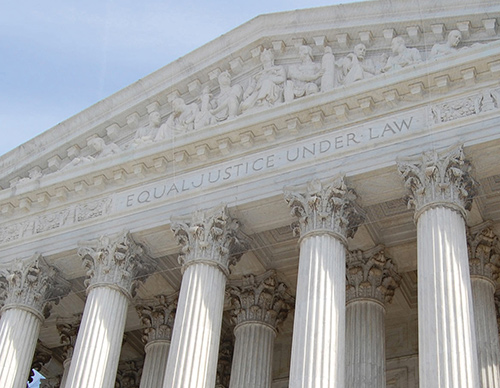 Engraved into the Supreme Court facade are the words “Equal Justice Under Law.” (EJI)
The Supreme Court vigorously defended the property rights of slave owners and enshrined the narrative of racial difference in its precedent by holding that Black people “had no rights which the white man was bound to respect,” whether they were enslaved
or not.58
Dred Scott v. Sandford,60 U.S. 393, 407 (1857).
Engraved into the Supreme Court facade are the words “Equal Justice Under Law.” (EJI)
The Supreme Court vigorously defended the property rights of slave owners and enshrined the narrative of racial difference in its precedent by holding that Black people “had no rights which the white man was bound to respect,” whether they were enslaved
or not.58
Dred Scott v. Sandford,60 U.S. 393, 407 (1857).
The Court struck down state laws to prevent slave traders from kidnapping free Black people and selling them into slavery59
Prigg v. Pennsylvania, 41 U.S. 539, 612 (1842).
and defended slave owners’ property rights by vacating the Missouri Compromise, which limited slavery in new United States territories.60
Dred Scott, 60 U.S. at 404-05.
Infamously, the Court’s 1857 decision in Dred Scott v. Sandford established that no Black person, free or enslaved, could be a citizen of the United States.61 Ibid. The Court reasoned that Black people “had for more than a century before been regarded as beings of an inferior order, and altogether unfit to associate with the white race, either in social or political relations,” and therefore, it is “absolutely certain that the African race were not included under the name of citizens of a State” and not entitled to the “privileges and immunities” of citizenship.62 Ibid., 408, 423.
During Reconstruction — the period immediately following the Civil War when an effort was made to defend the rights of formerly enslaved Black people — Congress passed three constitutional amendments: the Thirteenth Amendment abolished slavery and involuntary servitude; the Fourteenth Amendment overturned Dred Scott, declared all people born in the United States to be citizens, and guaranteed citizens due process and equal protection of the laws; and the Fifteenth Amendment prohibited denying a man the right to vote “on account of race, color, or previous condition of servitude.” The Supreme Court swiftly and systematically gutted all three.
The Fourteenth Amendment was designed to prevent states from violating the rights of formerly enslaved people. In 1872, in the
Slaughterhouse Cases, the Court nullified the amendment by holding that it could not limit the power of states to deny basic rights to their own citizens.63
The Slaughter-House Cases, 83 U.S. 36 (1873).
In 1875, in United States v. Reese, the Court held that the Fifteenth Amendment did not grant African Americans a federal right to vote,
64
United States v. Reese, 92 U.S. 214, 217-18 (1876).
struck down the statute Congress passed to protect African Americans’ voting rights, and overturned the convictions of two election officials who had refused to count a Black man’s vote.
65
Ibid., 215, 221-22.
As racial terror lynching raged throughout the South following the abolition of slavery, the Supreme Court repeatedly rendered the federal government powerless to protect African Americans from racial violence.
After killing as many as 150 Black people peacefully protesting at the courthouse in Colfax, Louisiana, in 1873, white defendants were convicted under a federal law designed to combat the Ku Klux Klan. 66 LeeAnna Keith, The Colfax Massacre: the Untold Story of Black Power, White Terror, and the Death of Reconstruction (New York: Oxford University Press, 2008), 75. The Court overturned their convictions in United States v. Cruikshank and struck down the statute, holding that Congress was empowered to regulate only state action, not the acts of private citizens — even if they committed murder.67 United States v. Cruikshank, 92 U.S. 542, 551-55 (1876).
The conceit of this private/state actor distinction was laid bare in Screws v. United States, when the Court overturned the conviction of a sheriff who, along with two other law enforcement officers, beat a handcuffed Black man to death.68 Screws v. United States, 325 U.S. 91, 92-93 (1945).
The Court not only shut down federal attempts to protect Black citizens, but also permitted state courts to deny justice to Black victims. While the Court struck down a law that excluded Black men from jury service solely based on race in 1879, it permitted states to create property and educational requirements for jury service and gave local officials nearly unfettered discretion to use those requirements to exclude African Americans. 69 Strauder v. West Virginia, 100 U.S. 303 (1880).
The Court made it so difficult to prove racial discrimination in jury selection that between 1904 and 1935, not a single conviction of a Black defendant was reversed because of racial discrimination in jury selection, even though African Americans were universally excluded from Southern juries.70 Michael J. Klarman, From Jim Crow to Civil Rights: The Supreme Court and the Struggle for Racial Equality (New York: Oxford University Press, 2004), 43. Meanwhile, all-white juries reliably acquitted white perpetrators of lynchings and other racial violence.
In 1898, in Williams v. Mississippi, the Supreme Court upheld Mississippi’s poll tax and other voting qualifications, even though the Court acknowledged they were adopted explicitly to disenfranchise African Americans, because the provisions
on their face were “not limited by their language or effect to one race.”71
Williams v. Mississippi, 170 U.S. 213, 225 (1898). The Supreme Court
acknowledged that the Mississippi Supreme Court had found that the
constitutional convention had intended to “obstruct the exercise of
suffrage” by African Americans. As the Mississippi court explained:
"By reason of its previous condition of servitude and
dependencies, this race had acquired or accentuated certain
peculiarities of habit, of temperament, and of character, which
clearly distinguished it as a race from the whites; a patient,
docile people, but careless, landless, migratory within narrow
limits, without forethought, and its criminal members given
to furtive offenses, rather than the robust crimes of the whites.
Restrained by the federal constitution from discriminating
against the negro race, the convention discriminates against
its characteristics, and the offenses to which its criminal members are
prone."
Ibid., 222 (quoting Ratcliff v. Beal, 20 So. 865, 868 (1896)).
And even though registrars used the qualifications to deny registration to all Black voters, the Court found “it has not been shown that their actual administration was evil; only that evil was possible under
them.”72
Ibid., 225.
Alabama voting laws were more explicitly discriminatory, but in Giles v. Harris, the Court found no constitutional problem with Alabama’s scheme, even when shown that Black men who met all qualifications were still refused registration.73 Giles v. Harris, 189 U.S. 475, 482 (1903). The Court concluded there was nothing it could do if Alabama was truly determined to prevent African Americans from voting, and so it denied all relief.74 Ibid., 487-88.
While the Court struck down an undeniably unconstitutional grandfather clause in Guinn v. United States in 1915, it upheld the use of literacy tests75 Guinn v. United States, 238 U.S. 347, 364-67 (1915). and poll taxes — tactics used to effectively deny voting rights to generations of African Americans for another 50 years.76 Breedlove v. Suttles, 302 U.S. 277, 283 (1937).
The Court struck down anti-segregation laws and upheld state laws that required segregation. In 1877, the Court in Hall v. DeCuir struck down a Louisiana law that prohibited segregation on all public conveyances within the state, 77 Hall v. De Cuir, 95 U.S. 485, 490-91 (1875). holding that it unconstitutionally regulated interstate commerce. 78 Ibid., 488-90. But a few years later the Court allowed a Mississippi segregation law to mandate racial separation on interstate railroad cars. 79 Louisville, N.O. & T. Ry. Co. v. State of Mississippi, 133 U.S. 587, 592 (1890).
Plessy v. Ferguson, the Court’s most well-known decision upholding segregation, considered a Louisiana law requiring racial segregation of railroad passengers and found no constitutional violation where facilities were “separate but equal.” Writing in 1896, the Court found that Louisiana’s law could not “abolish distinctions based upon color, or [] enforce social, as distinguished from political, equality, or a commingling of the two races upon terms unsatisfactory to either.” 80 Plessy v. Ferguson, 163 U.S. 537, 544 (1896). The Court rejected Mr. Plessy’s argument that forced racial separation branded Black people as inferior, and countered, “If this be so, it is not by reason of anything found in the act, but solely because the colored race chooses to put that construction upon it.” 81 Ibid., 551.
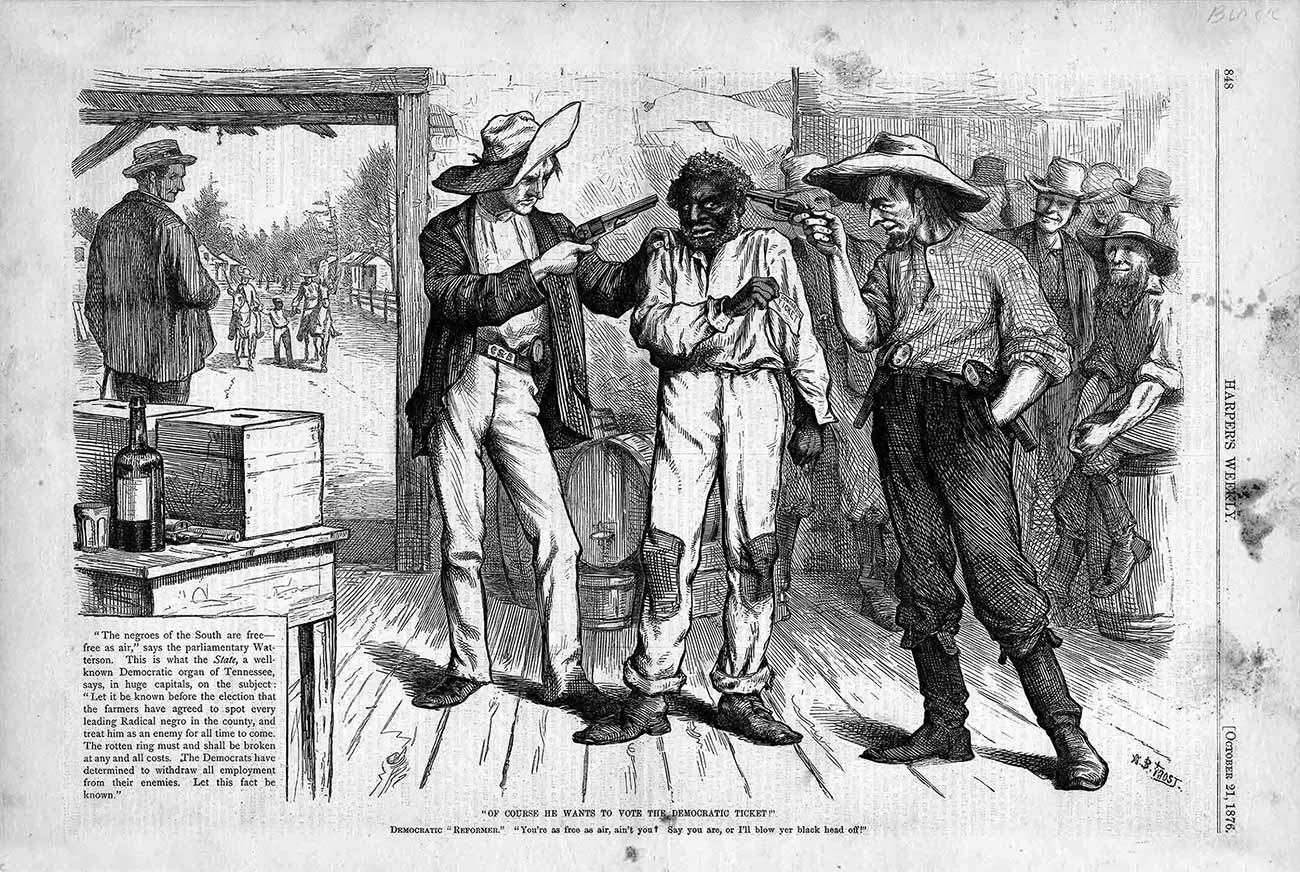
Harper’s Weekly, October 21, 1876. (A.B. Frost/Harper’s Weekly)
Even when enforcing its own “separate but equal” doctrine, the Court showed little commitment to the “equal” requirement. In Cumming v. Richmond County Board of Education, 55 years before Brown, the Court upheld the school board’s decision to close the Black high school but keep open the white high school because, it concluded, “it is impracticable to distribute taxes equally.” 82 Cumming v. Richmond Cty. Bd. of Ed., 175 U.S. 528, 542 (1899). The Court absolved itself of responsibility for ensuring equality in education, writing that “the education of the people in schools maintained by state taxation is a matter belonging to the respective states.” 83 Ibid., 545.
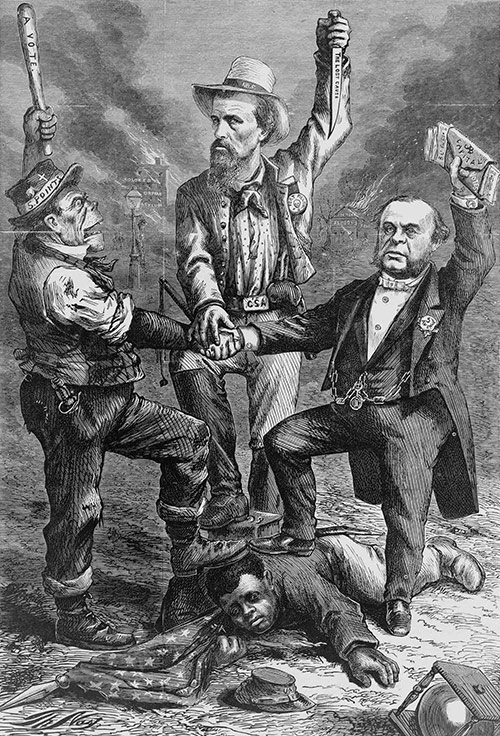 Harper’s Weekly, September 5, 1868. (Thomas Nast/Harper’s Weekly)
The Court’s embrace of Jim Crow extended even to voluntary associations between white and Black people. In
Berea College v. Kentucky, in 1908, the Court upheld a Kentucky law that prohibited private colleges from teaching Black and white students together, reasoning that the college, although private, was nonetheless dependent on a state charter,
and so was subject to virtually any conditions that Kentucky chose to impose.
84
Berea College v. Kentucky, 211 U.S. 45, 54 (1908).
Harper’s Weekly, September 5, 1868. (Thomas Nast/Harper’s Weekly)
The Court’s embrace of Jim Crow extended even to voluntary associations between white and Black people. In
Berea College v. Kentucky, in 1908, the Court upheld a Kentucky law that prohibited private colleges from teaching Black and white students together, reasoning that the college, although private, was nonetheless dependent on a state charter,
and so was subject to virtually any conditions that Kentucky chose to impose.
84
Berea College v. Kentucky, 211 U.S. 45, 54 (1908).
In 1875, Congress passed the Civil Rights Act, which barred racial discrimination in public accommodations, facilities, conveyances, and places of amusement. In the
Civil Rights Cases, the Court struck down the law, holding that Congress had no authority to prohibit discrimination by private parties.
The Court rejected the argument that the law was meant to eradicate the effects of slavery, writing that formerly enslaved people had already been given enough time and assistance and could not expect to forever be “the special favorite
of the laws.”
85
Civil Rights Cases, 109 U.S. 3, 25 (1883).